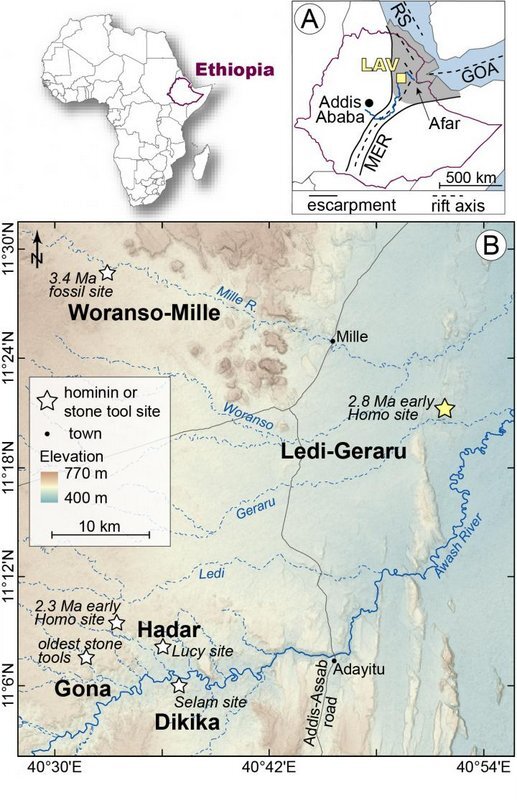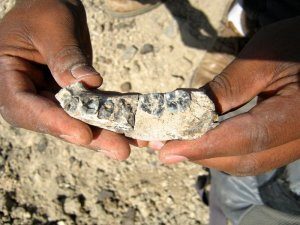
An international team has discovered a fossilized partial mandible (lower jaw) with five intact teeth representing an early human that, based on the dating, lived as much as 2.8 million years ago in what is today the Afar region of Ethiopia. It is now the oldest fossil evidence to date of a hominin in the genus Homo, the line that includes modern humans. The findings are reported in the journal Science, the publication of the American Association for the Advancement of Science.
Led by Brian A. Villmoare of the University of Nevada, Las Vegas, Arizona State University (ASU) scientists Kaye E. Reed, William H. Kimbel, Christopher J. Campisano and J. Ramón Arrowsmith, and geoscientist Erin N. DiMaggio of Penn State, the researchers discovered the fossil in 2013 in the Ledi-Geraru area of the Afar Regional State of Ethiopia (see images below), an area that also features other ancient mammal fossils, such as prehistoric antelope, water dependent grazers, prehistoric elephants, a type of hippopotamus and crocodiles and fish. The area is significant because it shows geological strata, or layers, that have been exposed due to geologic fault uplifting in the African Great Rift Valley system, where it is located. In other areas where uplifting has not taken place, the same strata have been long eroded away through time.
The fossil was first sighted by Ethiopian ASU graduate student Chalachew Seyoum on January 29, 2013 while conducting assigned surveying tasks. The 8 cm. long Ledi-Geraru mandible fossil represents the left side of the lower jaw and five teeth, still embedded within the mandible. Analysis of the fossil, led by Villmoare and William H. Kimbel of ASU’s Institute of Human Origins, has revealed features such as slim molars, symmetrical premolars and an evenly proportioned jaw, characteristics that have distinguished species of the Homo lineage from the more apelike characteristics of Australopithecus, an earlier hominin genus, of which one species is suggested by many scholars to have been a forerunner of the Homo genus. Yet some features of the Ledi-Geraru mandible, such as a more primitive, sloping chin morphology, is similar to that of the Australopithecines. It could suggest a possible bridge species between the Australopithecines and later Homo genus species. But it is too soon to assign the fossil to any specific species, say the researchers. There is not enough information yet to make a supportable designation.
__________________________________
Detailed map of where the Ledi-Geraru site is located in reference to other important fossil sites in Ethiopia. Credit Erin DiMaggio
_____________________________________
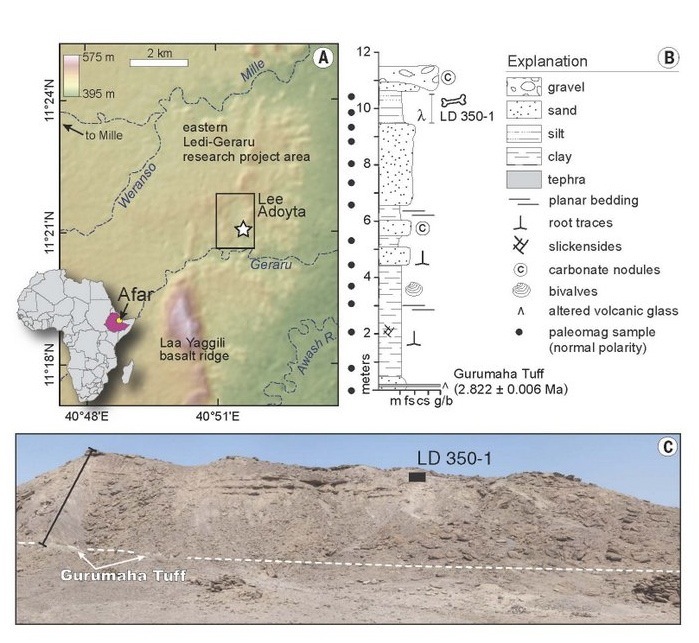 Site, geography, and geological stratification where the fossil jaw (designated LD 350-1) was discovered. Credit: Villmoare, et al.
Site, geography, and geological stratification where the fossil jaw (designated LD 350-1) was discovered. Credit: Villmoare, et al.
_______________________________________
“We used multiple dating methods including radiometric analysis of volcanic ash layers, and all show that the hominin fossil is 2.8 to 2.75 million years old,” said DiMaggio.
By dating volcanic ash/tuff layers below and above the fossil using argon 40/39 dating, a high-precision radiometric dating method that measures the decay through time of different isotopes of argon within the ash/tuff, scientists were able to calculate the ages of nearby associated ancient volcanic eruptions. In this way, geologists could determine the youngest and oldest dates when the Homo individual could have lived.
The variety of 2.8 – 2.75-year-old animal fossils found in the area indicates that the ancient landscape inhabited by the Homo individual was an open habitat of mixed grasslands and shrub lands with a gallery forest—trees lining rivers or wetlands, likely similar to African locations like the Serengeti Plains or the Kalahari.
Some researchers have also suggested that global climate change during that time created an environment of climate variability and aridity, triggering evolutionary changes in many mammal lines, including early humans.
“We can see the 2.8 million-year-old aridity signal in the Ledi-Geraru faunal community,” said Reed. “But it’s still too soon to say that this means climate change is responsible for the origin of Homo. We need a larger sample of hominin fossils and that’s why we continue to come to the Ledi-Geraru area to search.”
_____________________________________
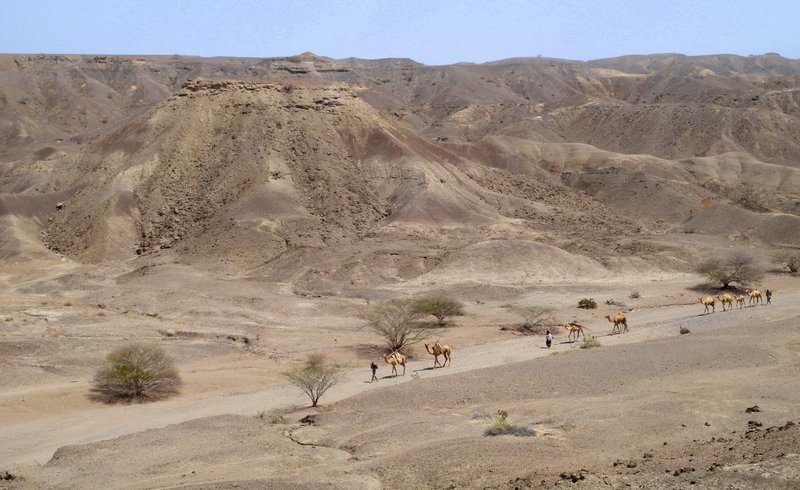 A caravan moves across the Lee Adoyta region in the Ledi-Geraru project area near the early Homo site. The hills behind the camels expose sediments that are younger than 2.67 million year old, providing a minimum age for the mandible. Credit Erin DiMaggio
A caravan moves across the Lee Adoyta region in the Ledi-Geraru project area near the early Homo site. The hills behind the camels expose sediments that are younger than 2.67 million year old, providing a minimum age for the mandible. Credit Erin DiMaggio
_____________________________________
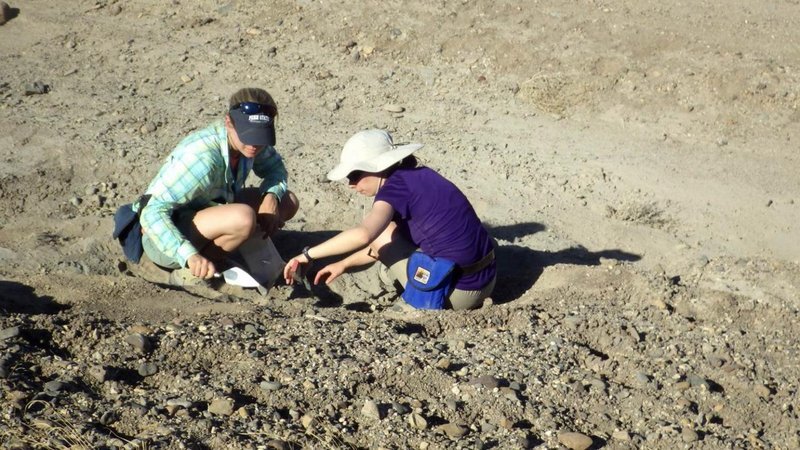 Geologists Dr. Erin DiMaggio of Penn State (left) and Dominique Garello (ASU, right) sample a volcanic tuff near the early Homo site in the Ledi-Geraru project area. Credit J. Ramón Arrowsmith
Geologists Dr. Erin DiMaggio of Penn State (left) and Dominique Garello (ASU, right) sample a volcanic tuff near the early Homo site in the Ledi-Geraru project area. Credit J. Ramón Arrowsmith
____________________________________
Most significantly, the Ledi-Geraru Homo fossil (designated LD 350-1) predates previously known fossils of the Homo lineage by about 400,000 years. Until now, the earliest credible fossil evidence of the Homo genus was dated to about 2.3 or 2.4 million years ago, as represented by the fossil mandible HCRP-UR 501 (see image below), found by the German paleoanthropologist Friedermann Shrenk at Uraha, Malawi. HCRP-UR 501 has been identified as belonging to Homo rudolfensis, an early Homo species that lived roughly contemporaneous with Homo habilis around 2 million years ago.
____________________________________
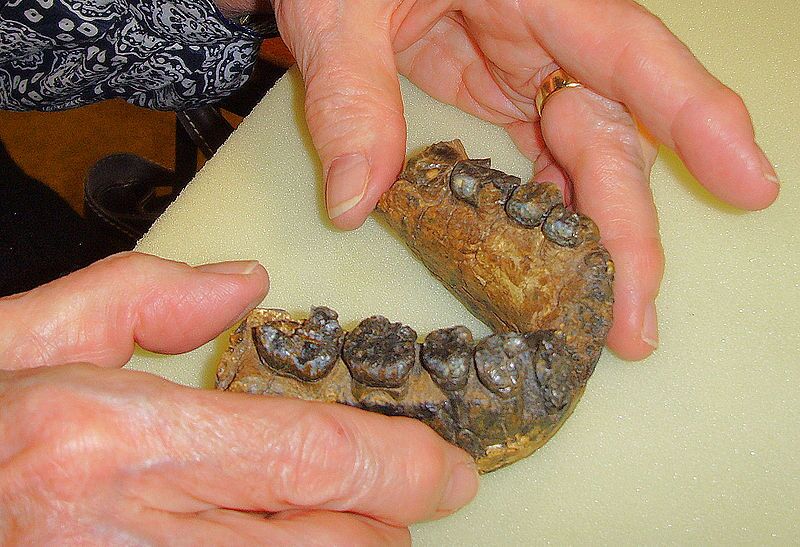 HPCR-UR 501, recovered by Friedermann Shrenk at Uraha, Malawi. Gerbil, Wikimedia Commons
HPCR-UR 501, recovered by Friedermann Shrenk at Uraha, Malawi. Gerbil, Wikimedia Commons
_____________________________________
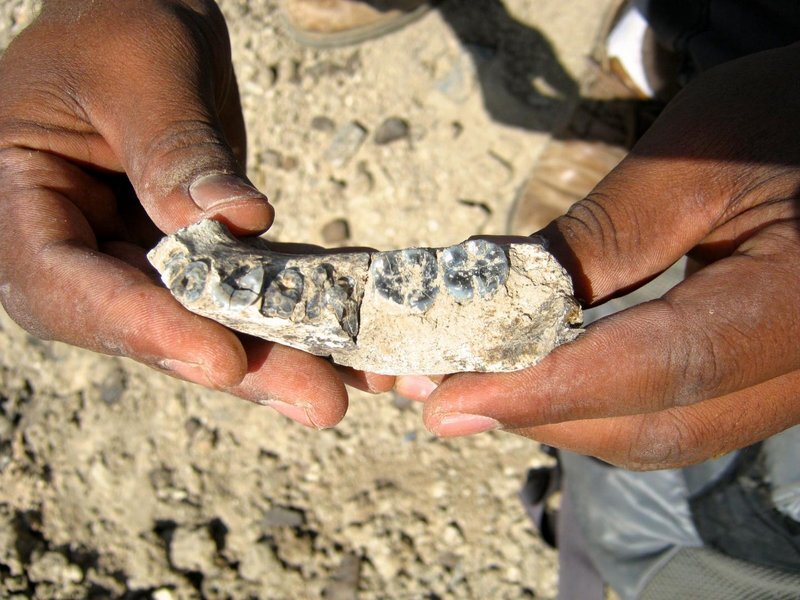 LD 350-1. Close-up view of the Ledi-Geraru partial mandible close to where it was sighted. Credit: Kaye Reed
LD 350-1. Close-up view of the Ledi-Geraru partial mandible close to where it was sighted. Credit: Kaye Reed
_____________________________________
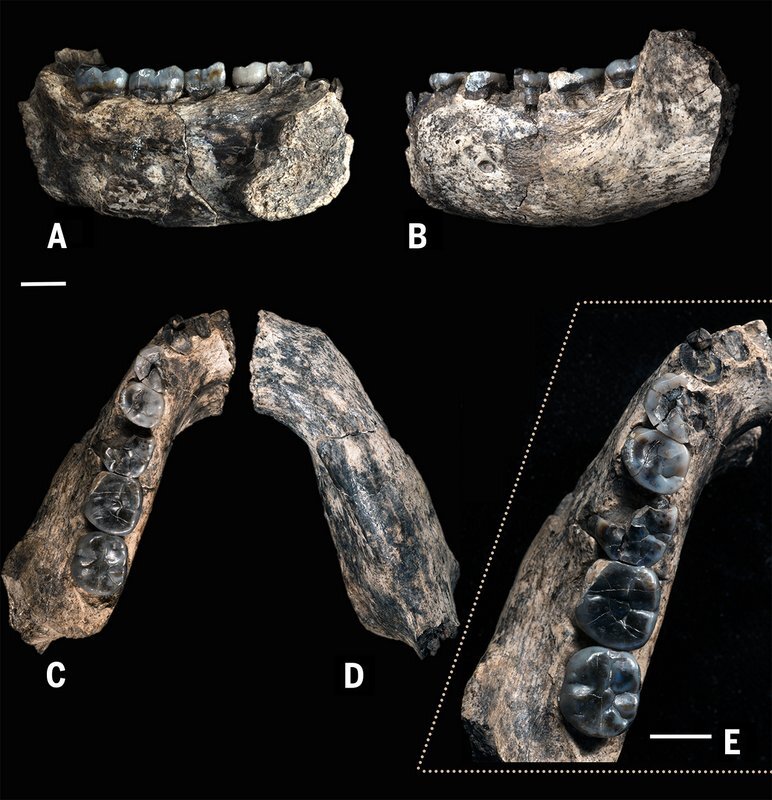 Close-up images of the Ledi-Geraru partial mandible, as seen from different angles and perspectives. Credit: William Kimbel
Close-up images of the Ledi-Geraru partial mandible, as seen from different angles and perspectives. Credit: William Kimbel
____________________________________
In a related report published in the journal Nature, Fred Spoor and his colleagues discuss a new reconstruction of the cranium and associated mandible belonging to the 1.8 million-year-old Homo habilis (“Handy Man”) from Olduvai Gorge, Tanzania. When first found by Mary and Louis Leakey on November 4, 1960, the fossil was in deformed condition. The reconstruction shows some surprising features that could help inform the discussion on where it might stand in relation to the Ledi-Geraru Homo within human evolution.
In any case, the researchers maintain that the new find from the Afar region represents a remarkable discovery.
“In spite of a lot of searching, fossils on the Homo lineage older than 2 million years ago are very rare,” says Villmoare. “To have a glimpse of the very earliest phase of our lineage’s evolution is particularly exciting.”
“The Ledi jaw helps narrow the evolutionary gap between Australopithecus and early Homo,” adds co-author William Kimbel of ASU. “It’s an excellent case of a transitional fossil in a critical time period in human evolution.”
The research team plans to continue their search for additional Homo fossils in the area of the find, hoping to shed additional light on the specimen and ultimately determine a suggested species designation.
Two detailed research reports* documenting the discovery are published in the journal Science, a publication of the American Association for the Advancement of Science.
*“Early Homo at 2.8 Ma from Ledi-Geraru, Afar, Ethiopia” by B. Villmoare et al., and “Late Pliocene Fossiliferous Sedimentary Record and the Environmental Context of early Homo from Afar, Ethiopia,” by E.N. DiMaggio et al.
__________________________________________________
The research team, which began conducting field work at Ledi-Geraru in 2002, included: Brian A. Villmoare (University of Nevada Las Vegas), William H. Kimbel (ASU Institute of Human Origins and School of Human Evolution and Social Change), and Chalachew Seyoum (ASU Institute of Human Origins and School of Human Evolution and Social Change, and Authority for Research and Conservation of Cultural Heritage, Addis Ababa), who analyzed the hominin fossil. Erin N. DiMaggio (Pennsylvania State University), Christopher J. Campisano (ASU Institute of Human Origins and School of Human Evolution and Social Change), J. Ramón Arrowsmith (ASU School of Earth and Space Exploration), Guillaume Dupont-Nivet (CNRS Géosciences Rennes), and Alan L. Deino (Berkeley Geochronology Center), who conducted the geological research. Faysal Bibi (Museum für Naturkunde, Leibniz Institute for Evolution and Biodiversity Science), Margaret E. Lewis (Stockton University), John Rowan (ASU Institute of Human Origins and School of Human Evolution and Social Change), Antoine Souron (Human Evolution Research Center, University of California, Berkeley), and Lars Werdelin (Swedish Museum of Natural History), who identified the fossil mammals. Kaye E. Reed (ASU Institute of Human Origins and School of Human Evolution and Social Change), who reconstructed the past habitats based on the faunal communities. David R. Braun (George Washington University), who conducted archaeological research.
_________________________________________________
Read about the most fascinating discoveries with a premium subscription to Popular Archaeology Magazine. Find out what Popular Archaeology Magazine is all about. AND MORE:
On the go? Get the smartphone version of Popular Archaeology as an app or as an ebook.
Just released!
The special new premium quality print edition of Popular Archaeology Magazine. A beautiful volume for the coffee table.
Travel and learn with Far Horizons.
____________________________________________
Popular Archaeology’s annual Discovery Edition eBook is a selection of the best stories published in Popular Archaeology Magazine in past issues, with an emphasis on some of the most significant, groundbreaking, or fascinating discoveries in the fields of archaeology and paleoanthropology and related fields. At least some of the articles have been updated or revised specifically for the Discovery edition. We can confidently say that there is no other single issue of an archaeology-related magazine, paper print or online, that contains as much major feature article content as this one. The latest issue, volume 2, has just been released. Go to the Discovery edition page for more information.

